Related Research Articles
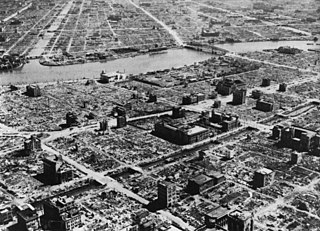
Strategic bombing is a systematically organized and executed attack from the air which can utilize strategic bombers, long- or medium-range missiles, or nuclear-armed fighter-bomber aircraft to attack targets deemed vital to the enemy's war-making capability. It is a military strategy used in total war with the goal of defeating the enemy by destroying its morale, its economic ability to produce and transport materiel to the theatres of military operations, or both. The term terror bombing is used to describe the strategic bombing of civilian targets without military value, in the hope of damaging an enemy's morale.

The Blitz was a German bombing campaign against the United Kingdom, in 1940 and 1941, during the Second World War. The term was first used by the British press and originated from the term Blitzkrieg, the German word meaning 'lightning war'.

Air Raid Precautions (ARP) refers to a number of organisations and guidelines in the United Kingdom dedicated to the protection of civilians from the danger of air raids. Government consideration for air raid precautions increased in the 1920s and 30s, with the Raid Wardens' Service set up in 1937 to report on bombing incidents. Every local council was responsible for organising ARP wardens, messengers, ambulance drivers, rescue parties, and liaison with police and fire brigades.
The Baedeker Blitz or Baedeker raids was a series of aerial attacks in April and May 1942 by the German Luftwaffe on English cities during the Second World War. The name derives from Baedeker, a series of German tourist guide books, including detailed maps, which were used to select targets for bombing.
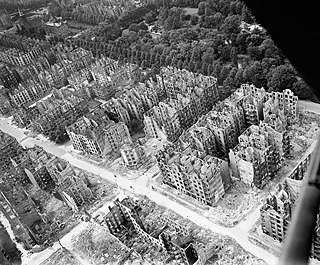
The Allied bombing of Hamburg during World War II included numerous attacks on civilians and civic infrastructure. As a large city and industrial centre, Hamburg's shipyards, U-boat pens, and the Hamburg-Harburg area oil refineries were attacked throughout the war.

World War II (1939–1945) involved sustained strategic bombing of railways, harbours, cities, workers' and civilian housing, and industrial districts in enemy territory. Strategic bombing as a military strategy is distinct both from close air support of ground forces and from tactical air power. During World War II, many military strategists of air power believed that air forces could win major victories by attacking industrial and political infrastructure, rather than purely military targets. Strategic bombing often involved bombing areas inhabited by civilians, and some campaigns were deliberately designed to target civilian populations in order to terrorize them and disrupt their usual activities. International law at the outset of World War II did not specifically forbid the aerial bombardment of cities – despite the prior occurrence of such bombing during World War I (1914–1918), the Spanish Civil War (1936–1939), and the Second Sino-Japanese War (1937–1945).
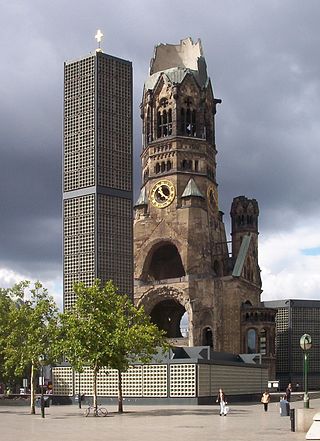
Berlin, the capital of Nazi Germany, was subject to 363 air raids during the Second World War. It was bombed by the RAF Bomber Command between 1940 and 1945, the United States Army Air Forces' Eighth Air Force between 1943 and 1945, and the French Air Force in 1940 and between 1944 and 1945 as part of the Allied campaign of strategic bombing of Germany. It was also attacked by aircraft of the Red Air Force in 1941 and particularly in 1945, as Soviet forces closed on the city. British bombers dropped 45,517 tons of bombs, while American aircraft dropped 22,090.3 tons. As the bombings continued, more and more people fled the city. By May 1945, 1.7 million people had fled.

The evacuation of civilians in Britain during the Second World War was designed to protect people, especially children, from the risks associated with aerial bombing of cities by moving them to areas thought to be less at risk.

This is a Timeline of the United Kingdom home front during World War II covering Britain 1939–45.

A blackout during war, or in preparation for an expected war, is the practice of collectively minimizing outdoor light, including upwardly directed light. This was done in the 20th century to prevent crews of enemy aircraft from being able to identify their targets by sight, such as during the London Blitz of 1940. In coastal regions, a shoreside blackout of city lights also helped protect ships from being seen silhouetted against the artificial light by enemy submarines farther out at sea.

The Belfast Blitz consisted of four German air raids on strategic targets in the city of Belfast in Northern Ireland, in April and May 1941 during World War II, causing high casualties. The first was on the night of 7–8 April 1941, a small attack which probably took place only to test Belfast's defences. The next took place on Easter Tuesday, 15 April 1941, when 200 Luftwaffe bombers attacked military and manufacturing targets in the city of Belfast. Some 900 people died as a result of the bombing and 1,500 were injured. High explosive bombs predominated in this raid. Apart from those on London, this was the greatest loss of life in any night raid during the Blitz.

The Birmingham Blitz was the heavy bombing by the Nazi German Luftwaffe of the city of Birmingham and surrounding towns in central England, beginning on 9 August 1940 as a fraction of the greater Blitz, which was part of the Battle of Britain; and ending on 23 April 1943. Situated in the Midlands, Birmingham, the most populous British city outside London, was considered an important industrial and manufacturing location. Around 1,852 tons of bombs were dropped on Birmingham, making it the third most heavily bombed city in the United Kingdom in the Second World War, behind London and Liverpool.
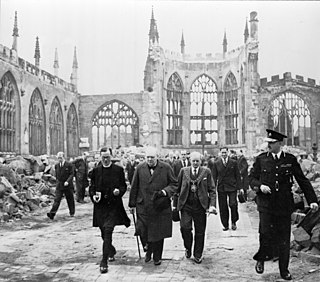
The Coventry Blitz, or Coventration of the city, was a series of bombing raids that took place on the British city of Coventry. The city was bombed many times during the Second World War by the German Air Force (Luftwaffe). The most devastating of these attacks occurred on the evening of 14 November 1940 and continued into the morning of 15 November.
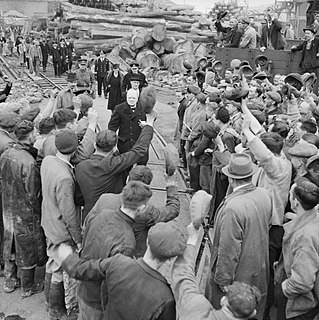
The Plymouth Blitz was a series of bombing raids carried out by the Nazi German Luftwaffe on the English city of Plymouth in the Second World War. The bombings launched on numerous British cities were known as the Blitz.

The Hull Blitz was the bombing campaign that targeted the English port city of Kingston upon Hull by the German Luftwaffe during the Second World War.

The United Kingdom took part in World War II from 3 September 1939 until 15 August 1945. At the beginning of the war in 1939, London was the largest city in the world, with 8.2 million inhabitants. It was the capital not just for the United Kingdom, but for the entire British Empire. London was central to the British war effort. It was the favourite target of the Luftwaffe in 1940, and in 1944-45 the target of the V-1 cruise missile, the V-2 rocket, and the unsuccessful V-3 "London gun".
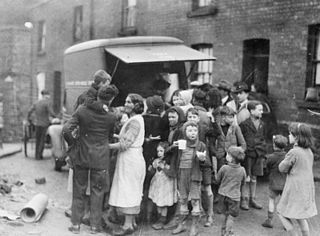
The Swansea Blitz was the heavy and sustained bombing of Swansea by the German Luftwaffe from 19 to 21 February 1941. A total of 230 people were killed and 397 were injured. Swansea was selected by the Germans as a legitimate strategic target due to its importance as a port and docks and the oil refinery just beyond, and its destruction was key to Nazi German war efforts as part of their strategic bombing campaign aimed at crippling coal export and demoralizing civilians and emergency services.
During World War II, a centralised state-run Emergency Hospital Service was established in the United Kingdom. It employed doctors and nurses to care for those injured by enemy action and arrange for their treatment across the range of local and charity hospitals that existed at that time. It was also known as the Emergency Medical Service, although this was, strictly speaking, the medical staff of the service.

The Newcastle Blitz refers to the strategic bombing of Newcastle upon Tyne, England by the Nazi German Luftwaffe during the second world war. Close to 400 people were killed between July 1940 and December 1941 during bombing raids on the city.

The United Kingdom home front during World War II covers the political, social and economic history during 1939–1945.
References
- Citations
- 1 2 3 Titmuss 1950, p. 271.
- ↑ Field 2002, p. 14.
- ↑ Field 2002, p. 44.
- ↑ Calder 2012, p. 219.
- ↑ Titmuss 1950, p. 272.
- ↑ Titmuss 1950, p. 307.
- 1 2 3 Titmuss 1950, p. 308.
- ↑ Clapson 2019, p. 57.
- 1 2 Barton 1997, p. 57.
- 1 2 3 Titmuss 1950, p. 309.
- 1 2 3 Titmuss 1950, p. 342.
- 1 2 Mackay 2002, p. 72.
- ↑ Mackay 2002, p. 81.
- 1 2 Clapson 2019, p. 53.
- ↑ Titmuss 1950, p. 344.
- ↑ Mackay 2002, pp. 81–82.
- ↑ Gore 2020, p. 52.
- Works consulted
- Barton, Brian (Autumn 1997). "The Belfast Blitz April-May 1941". History Ireland. 5 (3): 52–57. JSTOR 27724486.
- Calder, Angus (2012). The People's War: Britain 1939-1945. London: Random House. ISBN 9781448103102.
- Clapson, Mark (2019). The Blitz Companion: Aerial Warfare, Civilians and the City since 1911. London: University of Westminster Press. ISBN 9781911534495. JSTOR j.ctvggx2r2.
- Field, Geoffrey (Fall 2002). "Nights Underground in Darkest London: The Blitz, 1940-1941" (PDF). International Labor and Working-Class History. 62 (62): 11–49. doi:10.1017/S0147547902000194. JSTOR 27672803. S2CID 145612491.
- Gore, Jan (2020). The Terror Raids of 1942 The Baedeker Blitz. Barnsley, United Kingdom: Pen & Sword Books. ISBN 9781526745163.
- Mackay, Robert (2002). Half the Battle: Civilian Morale in Britain During the Second World War. Manchester: Manchester University Press. ISBN 9780719058943.
- Titmuss, Richard M. (1950). Problems of Social Policy. History of the Second World War. United Kingdom Civil Series. London: His Majesty's Stationery Office and Longmans, Green and Co – via Hyperwar Foundation.